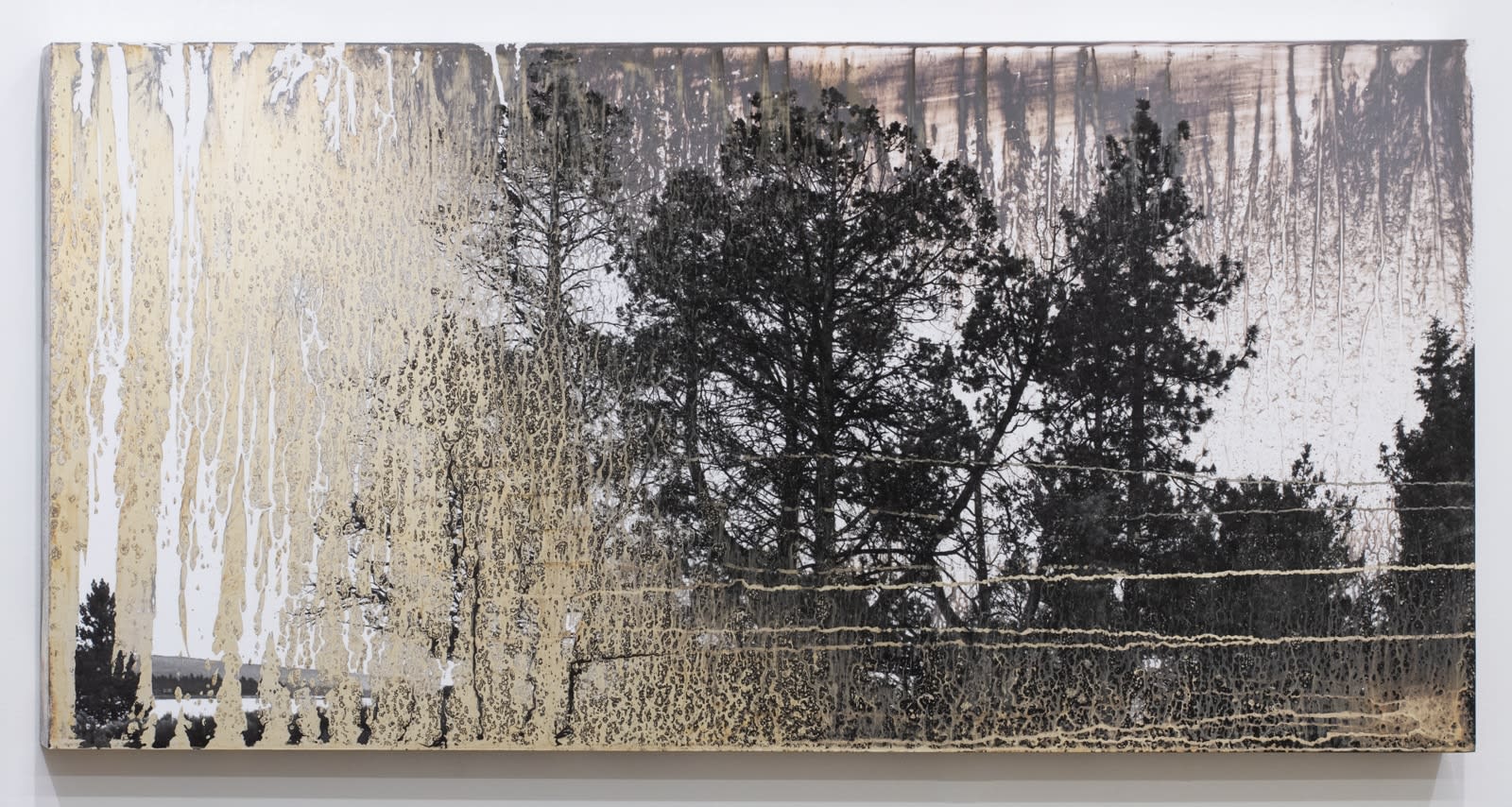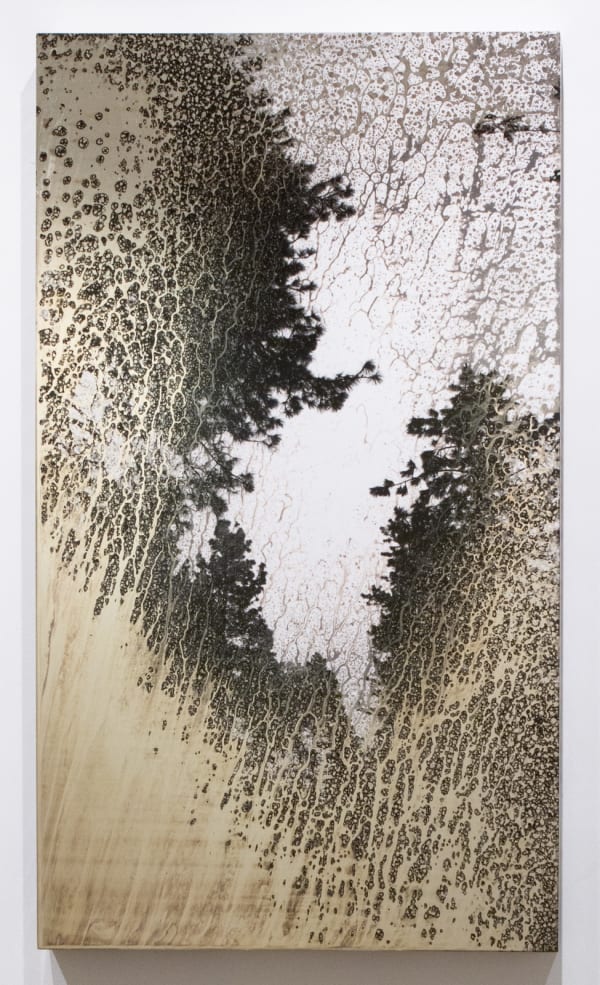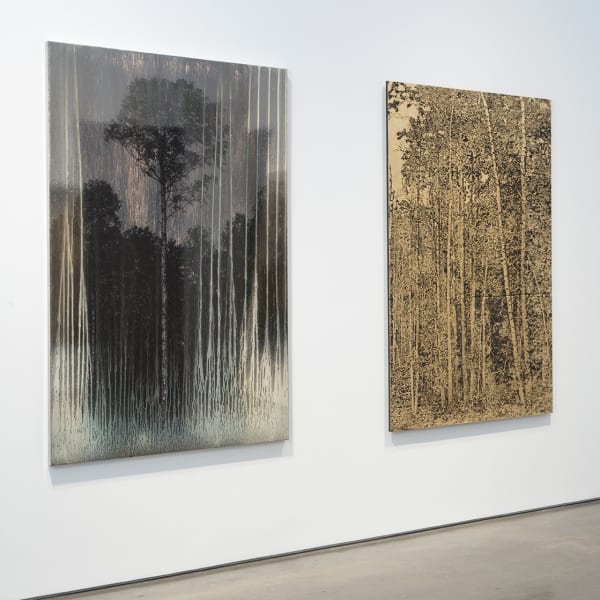-
For sales inquiries, please contact:
-
 AgXSB2111 (San Bernardino Forest), 2022-2023
AgXSB2111 (San Bernardino Forest), 2022-2023
Silver on Silver Gelatin Print Mounted on Aluminum
21" x 11 3/4" x 1 3/4" (53.5 x 30 x 4.5 cm)
Unique
(MBr.23439) -
It is the end when I feel an outcome becomes predictable and has lost the experimental energy and sense of play. The visual subject matter should relate to the material photographic form, and since my subjects often vary, my materials should too. – Matthew Brandt
-
 AgXSB2040 (San Bernardino Forest), 2023
AgXSB2040 (San Bernardino Forest), 2023
Silver on Silver Gelatin Print Mounted on Aluminum
20" x 39 3/4" x 1 3/4" (51 x 101 x 4.5 cm)
(MBr.23708) -
Detail Video of AgXSB2040 (San Bernardino Forest) (2023)
-
Brandt roams areas across the world, camera in hand, to create the images in this series, and the selection presented here focus on depictions of the San Bernardino Vallery. The artist locates stands of trees that can be broken down architecturally, isolated and captured against the sky as a backdrop in many individual photographs. Then, he composites these numerous images together to render the forms of the forest, resulting at times in gelatin prints so large that they require custom trays to develop. Finally, the artist seals the print with a clear coating, and applies a tinning solution that allows liquid silver to adhere in a process derived from antique methods of mirror manufacturing.The resulting work is layered and visually dense, yet often so reflective that the environment surrounding each piece becomes one with the details of the image as an inherent part of the work itself. The viewers are thus made visible to themselves, reflected back in the smooth surface of the liquid metal finish. This mirroring leads audiences to consider their relationship to the landscape, to the practice of photography, and to the environmental histories that remain visible across California and the world.Brandt’s different series often depict nature, with a particular focus on sites that are particularly active, or altered by human industry– including volcanic islands, polluted lakes, or the heavily intervened-upon landscapes of the American West. Originally from Los Angeles, the artist traces a line of history that connects the vintage photographic processes he employs and the landscape he depicts in a recognition of the central role photography played during the period of Westward Expansion in the early- to mid-nineteenth centuries. It was after his own return to Los Angeles from his studies in New York that Brandt was able to expand into his current practice in a mirroring of history.
-
The use of pictures of nature began as a ready-made subject. I liked how simple it seemed and it is a subject that is not questioned and hence allowed for an isolation on material. But now I am not sure that I look at making pictures of nature the same way, I have adopted a kind of romance. I have become interested in how one experiences nature and the primordial wonderment of things and processes. It is such a vast and inexhaustible subject. – Matthew Brandt
-
-
Much of human history is defined by surges of industry and interest in land, such as the Gold and Silver Rushes in California of the late nineteenth century. So too is the history of photography, which depends on many of these rare and precious materials in its manufacturing and its processes. Enmeshed in complex relationships to environmental and human rights, both histories find a crux on silver as a metal. Silver is crucial to establishing value as a resource and currency, and in turn as a reactive element in the photographic process. Utilized by humans since prehistory, silver has long played roles as bullion, specie, and ornament, and in modernity in electronics, medicine, and industrial manufacturing.Brandt’s Silver works are rendered by the chemical reactions of silver salts in developing the photographic print, and further illuminated through this mirrored treatment. Here, the artist’s subject becomes his medium: liquid silver flows through his images of lands where it historically had been sought. The illusory depth in this series parallels the deep importance that the metal plays in daily life. The photography industry’s dependence on silver is made central in Brandt’s works, as is its role in marketing new lands to those in search of resources over the previous century.
-
-
Drawing from the raw natural beauty and evident human legacy visible in locales across the world, Brandt’s work captures the physicality of both his materials and his subjects in experimental processes of his own making. Across his images of nature, the artist turns elements derived from the land back onto images that depict it, forming unpredictable material alliances that create new forms through an intentionally contentious nature. Like his various other series, Silver transforms his subject into his medium and his medium into his subject, capturing the entwined histories of photography, land, and the metal itself in a reflective body of work.
-
Related Content
-

Learn more about the artist
Visit Matthew Brandt's artist page on our website to learn more about his work
-

Learn More about Brandt's Guggenheim Fellowship
April 12, 2024Read more about the artist's inclusion in the 2024 Class of Guggenheim Fellows
-

Learn about the Herbert F. Johnson's acquisition of a Silver work
Museum Acquisition July 11, 2023Head to our website to find out more about the recent acquisition of AgXBSB2023 (San Bernardino Forest)
-

Learn More About Carbon, Birch, Silver, Rooms
October 29 - December 23, 2021Read more about Matthew Brandt's 2021 solo exhibition at Yossi Milo
-

Artforum Review
February 1, 2022Read about Carbon, Birch, Silver, Rooms in Artforum, reviewed by Donald Kuspit
-

![Matthew Brandt: Silver [Installation View] The Qube, Yossi Milo, New York Photo Credit: Olympia Shannon](/lib/archimedes/images/shim.gif)













